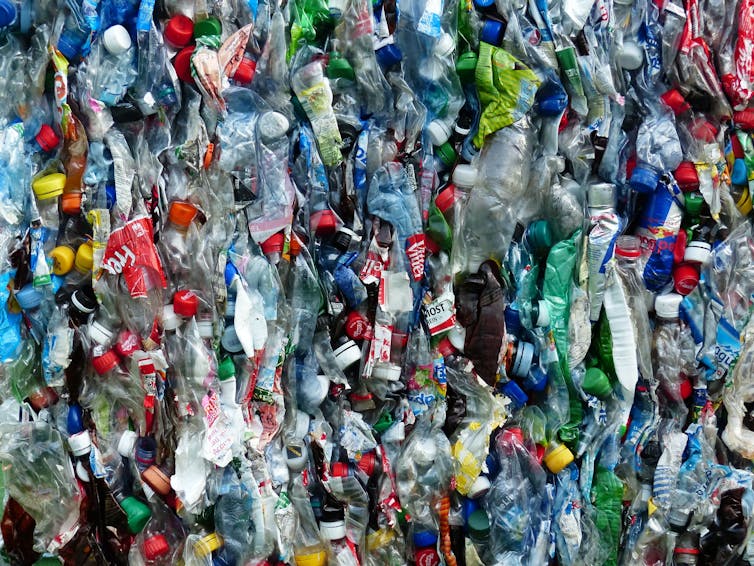The surprising way plastics could actually help fight climate change
- Written by Joseph Rollin, Postdoctoral Researcher in Bioenergy, National Renewable Energy Laboratory
What do your car, phone, soda bottle and shoes have in common? They’re all largely made from petroleum. This nonrenewable resource gets processed into a versatile set of chemicals called polymers – or more commonly, plastics. Over 5 billion gallons of oil each year[1] are converted into plastics alone.
Polymers are behind many important inventions of the past several decades, like 3D printing[2]. So-called “engineering plastics,” used in applications ranging from automotive to construction to furniture, have superior properties and can even help solve environmental problems. For instance, thanks to engineering plastics, vehicles are now lighter weight[3], so they get better fuel mileage. But as the number of uses rises, so does the demand for plastics[4]. The world already produces over 300 million tons of plastic every year. The number could be six times that by 2050.
Petro-plastics aren’t fundamentally all that bad, but they’re a missed opportunity. Fortunately, there is an alternative. Switching from petroleum-based polymers to polymers that are biologically based could decrease carbon emissions by hundreds of millions of tons every year. Bio-based polymers[5] are not only renewable and more environmentally friendly to produce, but they can actually have a net beneficial effect on climate change by acting as a carbon sink. But not all bio-polymers are created equal.
 Bioplastics don’t depend on drilling for oil since they get their carbon from CO₂ already in the atmosphere.
QiuJu Song/Shutterstock.com[6]
Bioplastics don’t depend on drilling for oil since they get their carbon from CO₂ already in the atmosphere.
QiuJu Song/Shutterstock.com[6]
Degradable bio-polymers
You may have encountered “bioplastics[7]” before, as disposable utensils in particular – these plastics are derived from plants instead of oil. Such bio-polymers are made by feeding sugars, most often from sugar cane, sugar beets, or corn, to microorganisms that produce precursor molecules that can be purified and chemically linked together to form polymers with various properties.
Plant-derived plastics are better for the environment for two reasons. First, there is a dramatic reduction in the energy required to manufacture plant-based plastics – by as much as 80 percent[8]. While each ton of petroleum-derived plastic generates 2 to 3 tons of CO₂, this can be reduced to about 0.5 tons of CO₂ per ton of bio-polymer, and the processes are only getting better.
 It’s one thing for a cup to easily disintegrate, quite another for your car’s components.
Michelle Kinsey Bruns/flickr, CC BY[9][10]
It’s one thing for a cup to easily disintegrate, quite another for your car’s components.
Michelle Kinsey Bruns/flickr, CC BY[9][10]
Second, plant-based plastics can be biodegradable, so they don’t accumulate in landfills.
While it’s great for disposables like plastic forks to biodegrade, sometimes a longer lifetime is important – you probably wouldn’t want the dashboard of your car to slowly turn into a pile of mushrooms over time. Many other applications require the same type of resilience, such as construction materials, medical devices and home appliances. Biodegradable bio-polymers are also not recyclable, meaning more plants need to be grown and processed continually to meet demand.
Bio-polymers as carbon storage
Plastics, no matter the source, are mainly made of carbon[11] – about 80 percent by weight. While petroleum-derived plastics don’t release CO₂ in the same way that burning fossil fuels does, they also don’t help sequester any of the excess of this gaseous pollutant – the carbon from liquid oil is simply converted into solid plastics.
Bio-polymers, on the other hand, are derived from plants[12], which use photosynthesis to convert CO₂, water and sunlight to sugars. When these sugar molecules are converted into bio-polymers, the carbon is effectively locked away[13] from the atmosphere – as long as they’re not biodegraded or incinerated. Even if bio-polymers end up in a landfill, they will still serve this carbon storage role.
CO₂ is only about 28 percent carbon by weight[14], so polymers comprise an enormous reservoir in which to store this greenhouse gas. If the current world annual supply of around 300 million tons of polymers were all non-biodegradable and bio-based, this would equate to a gigaton — a billion tons — of sequestered CO₂, about 2.8 percent of current global emissions[15]. In a recent report[16], the Intergovernmental Panel on Climate Change outlined capturing, storing and reusing carbon as a key strategy for mitigating climate change; bio-based polymers could make a key contribution, up to 20 percent of the CO₂ removal required to limit global warming to 1.5 degrees Celsius.
The non-degradable biopolymer market
Current carbon sequestration strategies, including geological storage[17] that pumps CO₂ exhaust underground or regenerative agriculture[18] that stores more carbon in the soil, lean heavily on policy to drive the desired outcomes.
While these are critical mechanisms for climate change mitigation, the sequestration of carbon in the form of bio-polymers has the potential to harness a different driver: money.
Competition based on price alone has been challenging for bio-polymers, but early successes[19] show a path toward greater penetration. One exciting aspect is the ability to access new chemistries not currently found in petroleum-derived polymers.
 Petro-plastic bottles can only be recycled a couple times max.
hans/pixabay, CC BY[20][21]
Petro-plastic bottles can only be recycled a couple times max.
hans/pixabay, CC BY[20][21]
Consider recyclability[22]. Few traditional polymers are truly recyclable[23]. These materials actually are most often downcycled, meaning they’re suitable only for low-value applications, such as construction materials. Thanks to the tools of genetic and enzyme engineering, however, properties like complete recyclability[24] – which allows the material to be used repeatedly for the same application – can be designed into bio-polymers from the beginning.
Bio-polymers today[25] are based largely on natural fermentation products of certain species of bacteria, such as the production by Lactobacillus of lactic acid – the same product that provides the tartness in sour beers. While these constitute a good first step, emerging research suggests the true versatility of bio-polymers is set to be unleashed in the coming years. Thanks to the modern ability to engineer proteins and modify DNA[26], custom design of bio-polymer precursors is now in reach. With it, a world of new polymers become possible – materials in which today’s CO₂ will reside in a more useful, more valuable form.
 Planes are starting to be made of polymers as well – bio-polymers are the next step.
Eric Salard/Wikimedia Commons, CC BY-SA[27][28]
Planes are starting to be made of polymers as well – bio-polymers are the next step.
Eric Salard/Wikimedia Commons, CC BY-SA[27][28]
For this dream to be realized, more research is needed. While early examples are here today – like the partially bio-based Coca-Cola PlantBottle[29] – the bioengineering required to achieve many of the most promising new bio-polymers is still in the research stage – like a renewable alternative to carbon fiber[30] that could be used in everything from bicycles to wind turbine blades.
Government policies supporting carbon sequestration would also help drive adoption. With this kind of support in place, significant use of bio-polymers as carbon storage is possible as soon as the next five years – a timeline with the potential to make a significant contribution to helping solve the climate crisis.
References
- ^ 5 billion gallons of oil each year (www.eia.gov)
- ^ 3D printing (theconversation.com)
- ^ vehicles are now lighter weight (www.chicagotribune.com)
- ^ so does the demand for plastics (www.springer.com)
- ^ Bio-based polymers (www.jbc.org)
- ^ QiuJu Song/Shutterstock.com (www.shutterstock.com)
- ^ bioplastics (www.acs.org)
- ^ by as much as 80 percent (doi.org)
- ^ Michelle Kinsey Bruns/flickr (www.flickr.com)
- ^ CC BY (creativecommons.org)
- ^ Plastics, no matter the source, are mainly made of carbon (www.nrel.gov)
- ^ derived from plants (theconversation.com)
- ^ carbon is effectively locked away (theconversation.com)
- ^ by weight (thinkprogress.org)
- ^ current global emissions (www.co2.earth)
- ^ recent report (www.ipcc.ch)
- ^ geological storage (theconversation.com)
- ^ regenerative agriculture (www.nytimes.com)
- ^ early successes (www.nrel.gov)
- ^ hans/pixabay (pixabay.com)
- ^ CC BY (creativecommons.org)
- ^ Consider recyclability (theconversation.com)
- ^ truly recyclable (mbdc.com)
- ^ complete recyclability (pubs.acs.org)
- ^ Bio-polymers today (www.ncbi.nlm.nih.gov)
- ^ modern ability to engineer proteins and modify DNA (www.jbc.org)
- ^ Eric Salard/Wikimedia Commons (commons.wikimedia.org)
- ^ CC BY-SA (creativecommons.org)
- ^ bio-based Coca-Cola PlantBottle (www.coca-colacompany.com)
- ^ renewable alternative to carbon fiber (science.sciencemag.org)
Authors: Joseph Rollin, Postdoctoral Researcher in Bioenergy, National Renewable Energy Laboratory

